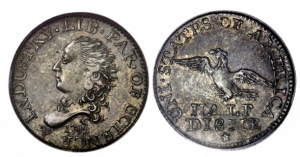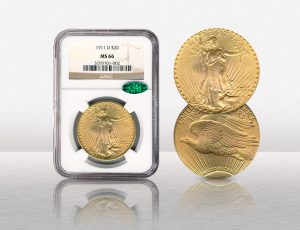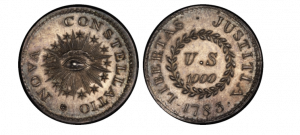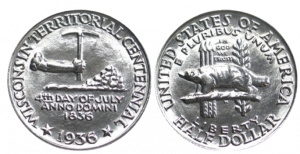Five Intriguing Error Coins Collectors Still Search For Today
Posted on — 3 Comments- 1802/01 Draped Bust Quarter Eagle
- 1906 Indian Head cent struck over a Mexican gold 5 peso coin
- 1937-D 3-Legged Buffalo Nickel
- The 1943 Lincoln Cent struck over a struck 1943 Mercury dime.
- The 2000-P Sacagawea dollar mule
When the U.S. Mint makes mistakes, coin collectors reap the benefits. Mint misstrikes and error coins are one of the most exciting areas in rare coin collecting. And these coins are often valued significantly higher than a coin in its intended condition. The scarcity and unique stories behind these coins create an allure and mystique within U.S. coin-minting history.
What’s more, errors rarely happen anymore, making earlier mistake coins even more valuable. A new coin production process began in 2002 which nearly eliminated error coins from going into circulation. Coins now are filtered through automated counters which flag imperfect coins. Thus, very few error coins have gone into circulation since 2002.
Let’s take a look at five intriguing error coins from history that rare coin collectors still search for today.
1. 1802/01 Draped Bust Quarter Eagle

The 1802/01 Draped Bust Quarter Eagle is an extremely scarce, unique overdated error coin. Overdate coins are early examples of mint errors. These occurred when a date or part of a date was punched into a finished working die that already featured an older date. It is estimated that there are roughly 200 U.S. mint overdates and experts believe these occurred amid die shortages or a desire to avoid the labor required to create a new die.
Modern technology removed the potential for overdates as the conditions which create overdates ended in 1909. The Indian Head Cent was the last issue where the date was punched into the working die by hand. In all years that followed, the date is included in the master die.
2. 1906 Indian Head Cent struck over a Mexican Gold 5 Peso

In 1906 an error occurred with the Indian Head penny that was struck over a Mexican gold 5-peso coin. Indeed, 1906 was the first year that this error could have been made as this is the year the U.S. Mint began striking coins for Mexico. It was also the only year that the U.S. Mint struck 5 peso coins, during which time they produced four million pieces.
3. 1937-D 3-Legged Buffalo Nickel

This may well be one of the most famous error coins in U.S. Mint history. In the rare coin world, a 1937 Nickel with a three-legged Buffalo has become a legendary numismatic prize.
Minted from 1913 through 1938, the imposing and memorable coin designed by James Earle Fraser features a handsome Native American on the obverse and a bison on the reverse. It is believed the “Black Diamond” buffalo in New York’s Central Park Zoo served as the inspiration for the coin’s reverse.
In 1937, the Denver Mint produced 17,826,000 of these legendary nickels composed of 75% copper and 25% nickel. That year, a Denver Mint employee named Mr. Young, took his job quite seriously. He over-polished the reverse die with an emery board in an effort to remove clash marks. The result of the excessively polished die variety? The front leg of the Buffalo missing! Hence the Denver Mint created three-legged Buffalo nickels in 1937. Collectors in the late 1930’s quickly discovered the Mint employee’s error and the 1937-D nickel became a classic even in its own time.
4. The 1943 Lincoln Cent struck over a struck 1943 Mercury Dime.

The 1943 Lincoln Cent struck over a struck 1943 Mercury Dime is a remarkable and rare double denomination error coin and is one collectors avidly seek. This was created when a dime was mistakenly fed into a printing press coining cents. This error coin combines the three-pronged popularity of the Lincoln Cent, the Mercury Dime and its 1943 date, caused by the desirability of the famous 1943 copper cents.
5. The 2000-P Sacagawea Dollar Mule

Sacagawea was a legendary Native American Shoshone woman who helped Meriwether Lewis and William Clark on their exploratory expedition from North Dakota across the Rocky Mountains to the Pacific Ocean and back in 1805-1806. Her work as an interpreter proved invaluable and also her presence in the group demonstrate the peaceful nature of the mission.
In the year 2000, the United States Mint honored Sacagawea and her contributions to the early explorations of our great nation with the Sacagawea Golden U.S. Dollar coin. The coin was minted under the auspices of the United States $1 Coin Act of 1997.
By and large the majority of Sacagawea coins are not rare and circulated coins do not carry numismatic value. They are also not made of gold, despite the golden color. The coins were composed of primary copper (77%), with small portions of zinc, manganese, and nickel.
However, a 2000-P Sacagawea dollar / Washington quarter mule error sold for $192,000 back in 2018. A mule is a coin struck with obverse and reverse dies that were not supposed to be paired with each other. In this case, the obverse reveals a Washington quarter, while the reverse reveals a Sacagawea dollar. About two dozen of these major errors were struck at the Philadelphia Mint.
Want to read more? Subscribe to the Blanchard Newsletter and get our tales from the vault, our favorite stories from around the world, and the latest tangible assets news delivered to your inbox weekly.
Gold Jumps as Inflation Data Weakens U.S. Dollar
Posted on — Leave a commentPrecious metals investors saw a nice lift to their portfolio last week. The price of gold jumped 1.8% following new economic reports signaling that

Gold bar on US dollar banknotes money, economy finance exchange trade investment concept. inflation is easing. That in turn weakened the U.S. dollar, which fell to its lowest level since April 2022 last week and also triggered expectations that the Federal Reserve may not have to raise interest rates as much as previously expected.
Spot gold climbed above $1,961 an ounce last week, hitting its highest level since early June.
The inflation report revealed that Consumer Price Index inflation rose 0.2% in June, and was up 3% from a year ago, the lowest level since March 21. Excluding food and energy, however, CPI inflation remained elevated with the core rate up 0.2% at a 4.8% year-over-year rate.
The drop in headline inflation spurred expectations that the Federal Reserve may not have to be as aggressive in continuing interest rate hikes as previously expected. That boosted gold as it removes some of the opportunity cost of holding gold, which doesn’t provide an interest rate.
Also fueling the strength in both gold and silver was fresh weakness in the U.S. dollar, which has been trending lower for the past nine months. A weaker dollar tends to support gold as the precious metal is bought and sold in U.S. dollars around the globe, which makes it less expensive for foreign buyers.
Gold Outperforming Stocks and Bonds
Overall, precious metals continue to deliver solid diversification and returns for bullion holders. In fact, gold is beating both U.S. stocks and bonds in July.
“So far this year, once again, you’ve been better off in a portfolio of 60% stocks, 30% bonds and 10% gold than in just 60% stocks and 40% bonds,” wrote Brett Arends in a July 14 MarketWatch article.
Bottom Line
Even though inflation is coming down, gold prices are still rising and investors remain bullish on the yellow metal in the near term. The latest Kitco Gold survey revealed that 61% of Main Street investors expect gold to increase this week.
Bigger picture, with expectations that the Fed may need to cut interest rates in 2024 that would allow gold to move even higher as the Fed’s interest rate hiking campaign has been a factor artificially holding gold back over the past year.
Want to read more? Subscribe to the Blanchard Newsletter and get our tales from the vault, our favorite stories from around the world, and the latest tangible assets news delivered to your inbox weekly.
The 1792 Half Disme: A Tiny Classic Coin Shrouded in Mystery
Posted on — 2 CommentsIn the early years of our young nation, America faced a new challenge—a shortage of small change. After years of relying on foreign gold and silver coins, America needed its own system of coinage, especially in small denominations.
One of the first tasks of the first Treasury Secretary Alexander Hamilton was to create a system for America’s coins. From Hamilton’s work, the Half Disme, or half a dime was the first American coin ever struck under the authority of the April 1792 Mint Act.
Yet just as fast as the first 1,500 1792 Half Dismes were minted, they disappeared from circulation. Even today, questions and intrigue surround this tiny coin with huge historical significance.
According to legend and lore, the many questions around the 1792 Half Disme included: Was the coin actually produced in the cellar of a mint contractor? Were the 1,500 Half Dismes created as pattern coins made for design approval, or were they business strikes meant to circulate among the public? Where did the bullion for the first strike come from—was it from President George Washington who as legend said donated his personal silverware?
For decades, scholars and numismatic collectors and coin dealers argued and chose sides on the questions swirling around the intriguing half disme. What was notable around the Half Disme’s launch was its lack of notoriety. There was no official government announcement, there is no evidence of a “first strike” ceremony and there was no newspaper coverage of this truly historic event for America.
It wasn’t until 1997 that verifiable proof emerged to answer some of those questions. The reason it took so long to find these answers is that they were buried in obscurity.
While serving as our nation’s first Secretary of State in 1792, Thomas Jefferson was also responsible for organizing the U.S. Mint. In fact, the Mint David Rittenhouse reported to Jefferson. So, it was in the personal papers of Thomas Jefferson that some of the answers swirling for over 200 years around the Half Disme were finally answered.
Jefferson tracked his personal income and expenditures in private memorandum books, and his 1792 memorandum book was not published until 1997 in The Papers of Thomas Jefferson. Here are the key findings that Jefferson noted in his memoranda book:
- July 10, 1792 entry: withdrew “100. D.” from the Bank of the United States, (likely Spanish silver dollars).
- July 11 1792 entry: “Delivd. 75. D. at the mint to be coined.”
- July 13, 1792 entry: “Recd. from the mint 1500. half dismes of the new coinage.”
According to the 1792 Mint Act, any U.S. citizen could bring bullion to the Mint and have it struck— weight-for-weight—into new silver or gold coinage of the United States. Jefferson’s memorandum book reveals that he did just that in July 1792—and that the half dismes were not minted from Washington’s personal silverware.
Jefferson’s careful documentation also provides answers to the pattern or business strike question that engulfed numismatics for decades.
After Jefferson received the 1,500 half dismes on July 13, 1792, he traveled with his daughter Maria from Philadelphia to his Virginia Monticello estate. On the way, that evening Jefferson and his daughter spent the night in Chester, Pennsylvania. He noted in his memorandum book for that date a tip to servants in the amount of 30 cents, signifying the use of six half dismes—for the first time in circulation.
The obverse of this illustrious coin reveals Liberty facing left, with the date shown below the bust. The words “INDUSTRY LIB PAR OF SCIENCE” fill the legend. The reverse features an Eagle facing left, with “HALF DISME” below and the words “UNITED STATES OF AMERICA.”
While the mintage for the 1792 Half Disme was 1,500, there are only 275 are estimated survivors. In 2018, a 1792 Half Disme, graded MS68 sold for $1,985,000. The First U.S. Mint Director David Rittenhouse owned that coin.
Want to read more? Subscribe to the Blanchard Newsletter and get our tales from the vault, our favorite stories from around the world, and the latest tangible assets news delivered to your inbox weekly.
The Five Most Famous U.S. Coin Designers
Posted on — Leave a comment- Augustus Saint-Gaudens

- Robert Scot
- Christian Gobrecht
- Charles E. Barber
- George T. Morgan
People collect rare coins for many reasons, including their historical significance and beautiful designs. Behind each rare coin stands a talented designer who left his lasting mark on the world, with hard currency that continues to increase in value today. In many instances, the coin designers worked at the United States Mint, while others were esteemed artists of their time. Let’s explore the fascinating history of the five most famous coin designers in the United States.
Augustus Saint-Gaudens
Born in Ireland in 1848, the son of a shoemaker, Augustus Saint-Gaudens grew up in New York City. After showing an early interest in art, by the late 1890s, Saint-Gaudens became one of the best-known and influential sculptors of his day.
In 1905, after viewing an exhibit of Greek coins at the Smithsonian, President Theodore Roosevelt was inspired to revamp the U.S. Gold Eagle ($10) piece and the Double Eagle ($20) gold coin. Roosevelt commissioned Saint-Gaudens to redesign and elevate these important early American U.S. gold coins into beautiful works of art. Experts widely agree that he succeeded. Saint-Gaudens played an outsized role in the development and beautification of early American coinage
The Saint-Gaudens “Double Eagle,” is considered today by many to be the most magnificent and sought-after U.S. coin of the 20th century. The Double Eagle is highly prized by collectors and has both intrinsic “rarity” value and vast appeal due to its alluring beauty.
Robert Scot
Robert Scot was the first Chief Engraver of the U.S. Mint. Scot was born in Scotland in 1745. After immigrating to America, he began his career engraving plates for Virginia currency banknotes. In 1781, Scot moved to Philadelphia with his family. He set up an engraving shop on the corner of Vine and Front Street.
In 1793, our young nation began to lay its groundwork—construction started on the Capitol building, and the office of Chief Engraver of the United States Mint was also created that year.
After the intended first Chief Engraver, Joseph Wright lost his life to Yellow Fever, George Washington appointed Robert Scot to replace him.
Scot’s early designs include the Flowing Hair silver dollar and the Liberty Cap half-cent. In 1795 Scot created the designs for the first gold coin of the U.S. Mint, with one design featuring a drapery for Lady Liberty. This design was then continued later on with the Draped Bust silver half dollar. In 1796, Robert Scot introduced the Heraldic Eagle reverse, which notably was a modification of The Great Seal of the United States. Today, the Heraldic Eagle still appears on many coins, ensuring Scot’s legacy lives on.
Christian Gobrecht
Christian Gobrecht was born in 1785 in Hanover, PA. As a young man, he apprenticed with a watchmaker and learned engraving. By 1811, Gobrecht was living in Philadelphia engraving bank notes and dies. Initially, his role was as an engraver at the U.S. Mint and eventually, he became the third Chief Engraver. He held the latter position from 1840 until 1844.
Gobrecht had a profound impact on early coinage in the United States. In 1836, Gobrecht designed his most famous work, the 1836 Flying Eagle Dollar. Today, collectors call this the Gobrecht dollar, and it is considered the basis for most of the Liberty Seated coinage that was created over the next 55 years. From half-cent copper coins to $10 gold pieces, Gobrecht’s designs were featured on nearly every denomination of coinage.
Charles E. Barber
Charles E. Barber, born in 1840, served as the sixth Chief Engraver of the United States, from 1879 until his passing in 1917. Barber had a long and prolific career as a coin designer. His best-known coin designs are the Liberty Head coins — Barber dime, Barber quarter, and Barber half dollar, as well as the “V” Liberty Head nickel.
Barber also designed the infamous $4 Stella “Flowing Hair” piece. In 1879, Congress authorized the U.S. Mint to produce a small test run of $4 gold coins so that Congressmen could review them and consider a proposal for a coin that could be used in international trade. Barber created a design that featured a portrait of Liberty facing left with long, flowing hair on the obverse, known today as the Flowing Hair type.
While the quest for an international coin failed and none of these pattern coins ever became a regular issue, collectors then and for generations have coveted these illustrious coins. After the limited run was produced, rumors surrounded the Stellas. While it was said that no coin collector could obtain a Stella from the U.S. Mint, the Congressman who had received the special order apparently used them as gifts and perhaps even payment. It was said that these great works of numismatic art were seen in special necklaces adorning the bosoms of Washington’s top madams, whose brothels were said to be patronized by those same congressmen.
George T. Morgan
George T. Morgan, born in England in 1845 ultimately became the seventh Chief Engraver of the United States Mint in 1917. Morgan is most famous for one of the most iconic designs in the history of U.S. coinage: the widely loved Morgan silver dollar.
The venerable Morgan silver dollar is one of the most popular coins in the numismatic community today. Nearly one billion Morgan silver dollar coins were minted from 1878 through 1921. The silver dollar was created to coin the metal mined from the enormous silver lodes that had been discovered in Nevada. While the first Morgan silver dollars were minted at the Carson City Mint from 1878 to 1893, others were produced in Denver in 1924 and in New Orleans from 1879-1904. Both Philadelphia and San Francisco minted the coins throughout their history.
There is rich and dramatic history for Morgan silver dollar collectors. Over 270 million Morgan silver dollars met their fate in the melting pot under the provisions of the Pittman Act of 1918. The U.S. government ordered this dramatic move to save Great Britain from a banking collapse and may have also helped the Allies win the war.
Want to read more? Subscribe to the Blanchard Newsletter and get our tales from the vault, our favorite stories from around the world, and the latest tangible assets news delivered to your inbox weekly.
Using Gold In a Strategy to Outperform the Market
Posted on — Leave a commentCan gold be more than a safe haven and actually beat the S&P 500 over the long term? One researcher believes the answer is yes.
In a paper from the Lead-Lag Report, researcher Michael Gayed, CFA tested a theory. He wanted to know if the performance of gold relative to lumber could give an investor insight into the future of the market.
His idea was simple: When lumber futures outperform gold, investors can take a more aggressive stance and move into small-cap equities, higher beta stocks, and cyclical sectors. In contrast, when gold outperforms lumber, investors should be less aggressive and move into Treasury bonds, use a buy-write strategy, or move into lower beta/volatility equities.
The basis of this strategy rests on two beliefs. The first is that rising lumber prices indicate that the economy is growing. The author suggests that lumber is especially sensitive to economic cycles given that the average new home in the US requires 16,000 board feet of lumber. This idea aligns with research from the National Bureau of Economic Research and their conclusion that “of the components of GDP, residential investment offers by far the best early warning sign of an oncoming recession.”
The second belief is that gold is a reliable and consistent store of value and that it is largely disconnected from so many other investment instruments. Data from the World Gold Council supports this assertion. Their research, covering more than 25 years of data, shows that “there is no statistically significant correlation between returns on gold and changes in macroeconomic variables, such as GDP, inflation, and interest rates.” Pivoting to gold when the economy suffers makes sense because “returns on gold are less correlated with equity and bond indices than the return on other commodities,” the World Gold Council explains.
So does this theory yield results?
According to the data in the paper, it does. The research shows that investors outperform the S&P 500 by a wide margin by moving into lower beta/volatility equities when gold outperforms lumber.
In fact, between November 1986 and November 2020, the S&P 500 yielded a return of 3,028% while a strategy of rotating into lower beta/volatility equities when gold outperforms lumber returned 4,076%.
While this strategy might not be practical for long-term buy-and-hold investors it does offer an important message. That message is that even over a period of decades, gold is remarkably consistent at signaling where the economy is headed. This reliability illustrates just how useful gold is for investors who want the assurance that at least some of their wealth is held in an asset that has prevailed across many downturns of different types.
Want to read more? Subscribe to the Blanchard Newsletter and get our tales from the vault, our favorite stories from around the world, and the latest tangible assets news delivered to your inbox weekly.
Your Mid-Year Portfolio Check-Up in Four Easy Steps
Posted on — 1 CommentThe year’s half-way over. Now is the perfect time to review your financial situation and your portfolio and make adjustments as needed – to ensure you are on track to meet your financial goals. Ready to get started?

Step 1: Evaluate your risk exposure.
Markets are changing, economic conditions are evolving and your financial goals may have even shifted from the last time you reviewed your portfolio. Take some time to consider how much “risk” you have in your portfolio.
The S&P 500 dropped nearly 20% in 2022. What would another big drop in the stock market mean to you? Would it hurt a near-term financial goal, perhaps a down payment for a home or even your retirement, if you plan to retire in the next several years? Be honest about your risk tolerance level. How you would feel if the equity portion of your portfolio dropped 20% from current levels.
If you have specific goals for your money in the next three to five years, experts often advise you not to invest those assets in the stock market. The reason? During down markets, history shows it can take up to five years for the broader equity market to move back to the breakeven point.
Step 2: Review your asset allocation mix.
Diversification is one of the key elements to successful investing. That simply means gaining exposure to different asset classes like stocks, bonds, tangible assets like physical gold and silver, and even cash. Do the math and calculate how much you currently have allocated to each asset class.
Risk-averse investors generally try to build portfolios in a way that reduces volatility without giving up overall returns. Research shows that both gold and coins have low betas, which means they are both effective assets for improving a portfolio’s performance without sacrificing return.
Blanchard believes that gold and silver bullion in physical form is an appropriate asset for a portion of any properly diversified investment portfolio and recommends investing up to 10% of your overall portfolio in gold, depending on your financial goals and risk tolerance levels.
Step 3: Calculate your liquid assets.
Having access to cash in a hurry when you need it is an essential part of any financial plan. Whether this is a cash reserve fund held in a high-yield savings account, or even held in physical metals (which can be sold instantly if you need dollars), having access to ready cash is important.
Experts typically recommend holding six months of living expenses in a cash reserve account. Or, if you are in retirement, holding up to three years of living expenses in a liquid account is key to ensuring you don’t have to pull out of investments potentially at a loss when you need money.
Physical gold can be considered for a portion of your liquid assets funds. Gold is considered a highly liquid asset because it’s easy to buy and sell. The market for gold is huge, global, and liquid. Gold prices are published 24/7 and gold can be readily sold anytime.
Step 4: Implement changes to your portfolio.
After you’ve reviewed, calculated, and considered the above, take steps to adjust your portfolio. This could include strategies like selling out of a portion of your equity exposure and buying physical metals, opening a self-directed IRA account to add physical gold and other precious metals to your retirement savings, or shifting a portion of your cash reserves into physical metals.
Want a second opinion? Get help from a professional.
If you’d like to discuss your financial goals with a Blanchard portfolio manager, give us a call today. We will take the time to learn your investment objectives, investment time horizon, and risk appetite before making any personalized recommendations for your consideration. We can also answer questions on topics including IRAs, inheritance, storage, and diversification. We’re here to help.
Want to read more? Subscribe to the Blanchard Newsletter and get our tales from the vault, our favorite stories from around the world, and the latest tangible assets news delivered to your inbox weekly.
A Study of How Commodities Perform During Inflation
Posted on — Leave a commentThe Federal Reserve’s ten rate hikes since March of 2022 have helped ease inflation in the US, but we’re not there yet. At a CPI of 4% year-over-year and core inflation that’s even higher, we’re still not at the 2% target.
This might not seem like a problem. After all, if ten rate hikes got us this far down from our peak of 9.1% in June of 2022, then a few more hikes should get us the rest of the way. In truth, the rest of the battle will likely prove difficult. Why? Because companies are still charging more for goods. Consider that groceries increased 8.2% year-over-year last month.
As one global strategist at Société Générale remarked, “Companies are not just maintaining margins, not just passing on cost increases, they have used it as a cover to expand margins.” The research supports this statement. Reporting from the New York Times shows that the average company in the S&P 500 has increased its net profit margin since the end of 2022. Between the pandemic and the war in Ukraine, these companies have many external factors to point to when justifying these increases. For weary consumers, these increases look more like opportunistic moves that will bolster the bottom line.
For investors, the problem is just as vexing. Inflation, while improving, is unlikely to return to the 2% level because rising prices have done little to dissuade consumers from buying. The question is: where can investors allocate more of their portfolio to protect themselves against inflation that might last longer than they can remain solvent?
Fortunately, a few researchers have attempted to answer this question. A paper, The Best Strategies for Inflationary Times, drafted by active investment company the Man Group and a Duke University academic, takes an empirical approach to this timely inquiry.
The group analyzed passive and active strategies among various asset classes during the last 95 years. Their work focused on the US, UK, and Japanese markets. The researchers identified eight periods of rising inflation – defined as a 5% acceleration year-over-year – in the US. During these eight periods, the group examined the performance of equities, commodities, real estate, and fixed income.
They discovered that during inflation commodities have “a perfect track record of generating positive real returns” and generated an average annualized +14% real return.
Gold was part of the commodity group that they analyzed. Specifically, the metal generated an annualized real rate of return of 13% during inflationary periods in the US. This performance even outpaced other commodities like agricultural goods including wheat, corn, soybeans, sugar, cocoa, cotton, coffee, and livestock. Gold also outperformed equities, TIPS, real estate, 2-year Treasuries, 10-year Treasuries, 30-year Treasuries, high-yield fixed income, and consumer durables.
What makes this finding so valuable for investors is that it covers such a range of periods and such a diverse group of assets. Moreover, the research shows that, unlike many other assets, gold still largely held its value even when inflation was not present.
Now is the time for investors to benefit from research like this as the fight to get back to 2% drags on and threatens to be long.
Want to read more? Subscribe to the Blanchard Newsletter and get our tales from the vault, our favorite stories from around the world, and the latest tangible assets news delivered to your inbox weekly.
Nova Constellatio Patterns Coins: The Foundation of Our Numismatic Legacy
Posted on — 1 CommentIn 1783, after eight difficult years, Great Britain declared it would cease hostilities with the United States, creating an end to the long Revolutionary War. The 1783 Treaty of Paris officially ended the war and recognized the United States as an independent nation.
Now, our young nation faced its next serious problem. At that time, there was no official coinage and the thirteen early American states all used different forms of official or unofficial money.
Robert Morris, who served as the U.S. Superintendent of Finance from 1781 to 1784, could be considered the father of the 1783 Nova Constellatio pattern coins and the solution to the young nation’s currency challenges.
Morris began to work with each of the 13 states and their tangled web of monetary systems. He developed a concept of national coinage with a system of 1,000 units that would allow all but one of the thirteen states to normalize their state currency against the proposed national coinage.
This system included a silver Mark of 1,000 Units, a silver Quint of 500 Units, a silver Cent of 100 Units, a copper Eight of 8 Units, and a copper Five of 5 Units.
These ultra-rare and historic early American Nova Constellatio pattern coins were struck in Philadelphia in 1783 under the authority of the U.S. Treasury Department. Benjamin Dudley, an English emigrant and a metallurgist was tasked to prepare dies and strike examples of these denominations. How many pattern coins were struck remains a mystery today and any survivors are ultra-rare. There are five different 1783 Nova Constellatio pattern coins.
If you took Latin in high school, you may recall that Nova Constellatio is Latin for “new constellation.” The aptly named 1783 Nova Constellatio patterns coins reveal thirteen stars among the rays of glory representing all thirteen states as a “new constellation“ surrounding the eye of God. The coins featured the Latin words LIBERTAS and JUSTITIA, intended to signal that Liberty and Justice would govern the new nation.
After all that work, Morris’ coinage plan never got off the ground. The proposal never emerged out of the Continental Congress’s committee that was assigned to consider it. Nonetheless, the intriguingly beautiful Nova Constellatio pattern coins represent an important part of our nation’s early history and America’s numismatic legacy.
Want to read more? Subscribe to the Blanchard Newsletter and get our tales from the vault, our favorite stories from around the world, and the latest tangible assets news delivered to your inbox weekly.
New Data Shows Inflation Is Still Hot, Hot, Hot
Posted on — 1 CommentKind of like the uncle who keeps sticking around long after dinner has ended, inflation is proving hard to say goodbye to.
Ten interest rate hikes later, the Federal Reserve still hasn’t stuffed the inflation genie back into the bottle – as the central bank battles with the highest levels of inflation in the United States since the early 1980s.
New data reveals that despite the most aggressive interest rate hike campaign in history – inflation still isn’t slowing and it’s hot, hot, hot, which means the Fed will likely keep on raising interest rates this summer.
The Personal Consumption Expenditure (PCE) price index headline number jumped 4.4% for the 12 months ending in April, the Commerce Department reported.
The Fed’s preferred inflation gauge and more closely watched core PCE index – which strips out volatile food and energy costs – unexpectedly climbed 4.7% for the year. Surging goods prices led the index higher, including price increases for motor vehicles and parts. Spending on financial services and insurance led the services portion of the index.
Overall prices for services, which include items like medical care, transportation, and hospitality hit, an annual increase of 5.5%. Food prices skyrocketed 6.9% on an annual basis in the latest report.
The overall inflation number is still more than double the Fed’s inflation target at 2%. And, still rising prices of goods and services reveals that inflation has yet to be tamed.
The Fed meets next on June 13-14 and the report triggered speculation the central bank may need to hike again at that time.
Gold has proven diversification properties
As the government fails to put out the inflation fire – the spotlight shines brightly on gold. Throughout history, gold has served as a stable medium of exchange, a hedge against inflation, and today it serves investors well as a private investment outside the global financial system.
Gold and silver bullion ownership serve investors well as safety nets and insurance for their wealth. Allocating up to 10% of your portfolio to precious metals is a prudent diversification method with proven results to reduce volatility in long-term portfolio returns.
As the purchasing power of your paper dollars is eroded every day by inflation, have you considered if now is the time to trade more of those dollars for a hard asset like gold to protect and grow your wealth?
Want to read more? Subscribe to the Blanchard Newsletter and get our tales from the vault, our favorite stories from around the world, and the latest tangible assets news delivered to your inbox weekly.
The 1936 Wisconsin Territorial Centennial Half Dollar
Posted on — Leave a commentIn 1936 the Wisconsin Centennial Commission appointed a Coinage Committee to pursue the development and minting of a commemorative coin to celebrate and help finance the Wisconsin Centennial that year.
The Wisconsin Centennial half dollar came at a time when the commemorative coin market was booming. This surge was due to previous commemorative coins that were minted in low quantities causing them to appreciate in value significantly. Many of these pieces sold at a premium to their earlier prices.
By the end of March of 1936 the Senate passed the bill paving the way for the half dollars. From there, the bill moved on to the House of Representatives where an amendment was requested which would increase the authorized minting to 25,000.
The job of designing the coins fell to David Parsons, a local art student. The only stipulations he was given was that the seal of Wisconsin Territory had to appear on one side, and a badger had to be on the other. However, his designs were deemed unsuitable mostly due to the light relief that did not adequately show the detail of the art. After the Bureau of the Mint rejected his work, the Wisconsin Centennial Commission tasked New York sculptor Benjamin Hawkins with the job of designing the coins. After being given a three week deadline, Hawkins submitted his designs which the Commission of Fine Arts approved almost immediately.
The image on the obverse, a miners arm gripping a pickaxe, meant to represent the mining activities that drew so many to southeast Wisconsin in the 1820s. In fact, a lead mining boom started in the late 1820s. The metal was so important at the time that many called it “gray gold.”
The badger on the reverse was selected because it is the state animal. This choice also reflects the fur-trading business that characterized the area at the time. The three arrows behind it illustrated the conflict between early settlers and the Black Hawk Indians. The olive branch next to the arrows is meant to symbolize the peace that followed. However, some contend that this “peace” was nothing more than the forceful expulsion of Indians from their land. The “H” appearing below the badger marks the work as Hawkins’.
The Philadelphia Mint struck the coins and made them available to collectors via mail order at a cost of $1.50 per coin. The composition of the coin, 90% silver, 10% copper, made it more valuable than the face value of $0.50. Organizers marketed the coin at the Centennial Cavalcade of Wisconsin in late July of 1936. The complete minting was sold by the1950s.
Today the images on the coin recall the early days of Wisconsin before its admission to the Union in 1848. Prior to this, the Wisconsin Territory had been part of the Northwest Territory before the British gave up the region amid the Treaty of Paris. The coin is a reminder of the hard-won land that became, and remains, such a part of America’s identity.
Want to read more? Subscribe to the Blanchard Newsletter and get our tales from the vault, our favorite stories from around the world, and the latest tangible assets news delivered to your inbox weekly.








